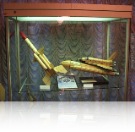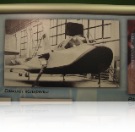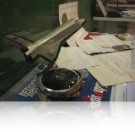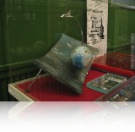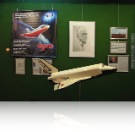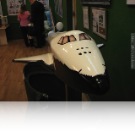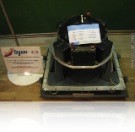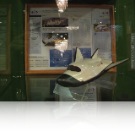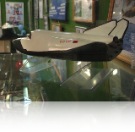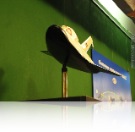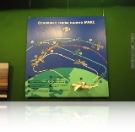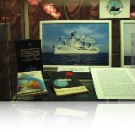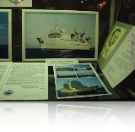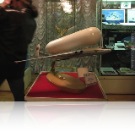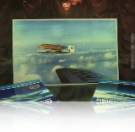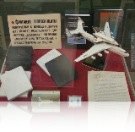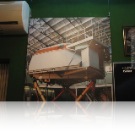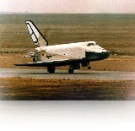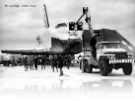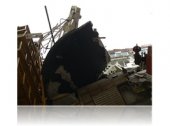Archives for 'Energia'
New part on the VM-T Atlant plane
I published a complet part about the carrier plane VM-T Atlant.
This plane was made by the Myasishchev design office to carry the tanks of the Energia launch vehicule and the Buran shuttles from Moscow to Baikonur.
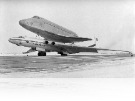
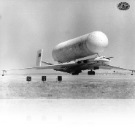
Posted on:
2009-01-02 under
Buran, Energia, Mriya, VM-T Atlant, Web Site.
4 comments
»
Anniversary at Tushino
An exposition about the Buran-Energia project took place at Tushino from October 31 to November 23, 2008, it was about the 20th anniversary of the first flight of Buran.
One can see Strizh and Orlan spacesuit (made by Zvezda), miscellaneous former documents, some model kit (Buran, Mriya, BOR/EPOS), and lots of pictures.
Source: orbicraft.livejournal.com
Posted on:
2008-11-28 under
Buran, Energia, Mriya, Polyus, VM-T Atlant, BOR, Spiral.
Commentaires fermés
20 years since the first flight of Buran
Today it’s the 20th anniversary of the historic flight of Buran.
It is the 15 November 1988 at 6 o’clock of the morning, Moscow’s time, that the Energia rocket lifted bellow a dense cloud layer, with the 80t Buran space shuttle. It was the second launch of Energia, in more than a year, and it was a success. Buran was put in orbit at an altitude of 250-260 km (slope 51.6°, like MIR).
After 2 orbits the de-orbit command was send and Buran began her descent to the Kazakhstan. The shuttle glide itself to the Baikonur’s airport when she suddenly turn 90° compared with the landing strip. In the control center they hold their breath, she can’t fail so near ! Hopefully the steerage was normal, the computer choose to turn to decrease the speed. Some instant later the shuttle face the 5 km long landing strip, specially built for it.
Buran land at 360 km/h and stop after 1820m, at 5m from the center and 1s in advance on the schedule!
It is 12 years of unremitting work that concretise, in the control center and on the landing strip workers, technicians and engineers burst into joy. It’s also a huge thumbing to USA’s nose. After the fail of the Soviet lunar program, the USSR came back into the spotlight by surpassing the jewel of the American space program, the Space Shuttle.
For 20 years no other spacecraft had achieved the Buran’s exploit, that is to say flying in automatic mode from the launch pad until the landing on the runaway, because this is the true exploit on Buran, flying in totaly automatic mode.
Unfortunatly, if no-one ever done it again nor Buran. In fact, it was her unique flight ever. As if the only fate of Buran was to show the world that the Soviet Union was still in the space race. Because Energia-Buran is an expensive project, 16 billion rubles, and had a lot of delay from the original schedule, the already starving economy of the USSR can’t bear it and its collapse at the end of 1991 freezes the project.
In 1993, Boris Eltsine stop definitively the financial of the project, which nearly hadn’t evolved since the flight of 1988. Energia-Buran is dead. The burrying will take place in may 2002 when the roof of the hangar collapse on Buran, killing 7 workers, and stopping rumors about re-starting the project.
Since 20 years thoughts had evolved about spacecrafts (manned or unmanned). If the Russia wants to reuse its knowledge for Klipper (mini space shuttle) the Soyuz has still favours of Roskosmos, the USA reject now this type of spacecraft by stopping the shuttle flights in 2010.
Posted on:
2008-11-15 under
Buran, Energia.
Commentaires fermés
Pictures of the 1.01 Buran space shuttle destroyed
Here is some pictures of the destroyed 1.01 Buran space shuttle (the only model which flown) and the Energia launcher. After its historical flight the shuttle was parked in the 112 hangar piggy backed of an Energia launcher. Unfortunatly in 2001 the roof collapsed during its renovation, destroying the shuttle and the launcher and killing 7 workers.
Those pictures were taken in the begining of the year 2008.
Posted on:
2008-08-31 under
Baikonur, Buran OK-1.01, Energia.
4 comments
»
Reporting on Buran-Energia project on the American TV
Here is a small reporting about the Buran-Energia project which was broadcasted on American television on last November15, for the 19th anniversary of the first flight of the shuttle.
Posted on:
2008-01-12 under
Buran, Energia, Web Site.
1 comment
»
Triumph and tragedy of the rocket launcher « Energia »
 Triumph and tragedy of « Energia » is a book about the most powerful launcher in the world: Energia. Written by Boris Ivanovich Gubanov, project manager, he tells the tragic history and the anecdotes of the elaboration of the launcher, as well as the vision of the Soviet’s space in the 2000s.
Triumph and tragedy of « Energia » is a book about the most powerful launcher in the world: Energia. Written by Boris Ivanovich Gubanov, project manager, he tells the tragic history and the anecdotes of the elaboration of the launcher, as well as the vision of the Soviet’s space in the 2000s.
Posted on:
2007-11-26 under
Energia, Polyus, Web Site.
5 comments
»
2007, the space year
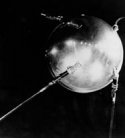 On May 15th, 1957 (50 years ago), the USSR proceeded to its first rocket fire, R7 (it exploded some minutes later). It is only October 4th of the same year that R7 put into orbit successfully the Sputnik, first artificial satellite of the Earth. This historic launch was going to open the gates of the space conquest. Conquest won at first by the tremendous leadership of the Soviets (first satellite, first man in the space, first woman in the space, first pedestrian spatial), but these last ones were overtake by the Americans and lost the race to the Moon.
On May 15th, 1957 (50 years ago), the USSR proceeded to its first rocket fire, R7 (it exploded some minutes later). It is only October 4th of the same year that R7 put into orbit successfully the Sputnik, first artificial satellite of the Earth. This historic launch was going to open the gates of the space conquest. Conquest won at first by the tremendous leadership of the Soviets (first satellite, first man in the space, first woman in the space, first pedestrian spatial), but these last ones were overtake by the Americans and lost the race to the Moon.
At the end of the 70s the Soviets decided to come back on the front scene after the bitter echec of N1, they launch the Buran-Energia project, the heavy thrower Energia of which allows to put on low orbit 100 t of payload.
 It is the May 15th, 1987 (20 years ago) the first launch of Energia took place. Initially planned with a fictitious payload (placed on the side of the thrower), the launch will be made finally with the Polyus system. But after a breakdown of the Polyus‘s propulsion system it was not able to reach its working orbit and crashed in the Pacific Ocean.
It is the May 15th, 1987 (20 years ago) the first launch of Energia took place. Initially planned with a fictitious payload (placed on the side of the thrower), the launch will be made finally with the Polyus system. But after a breakdown of the Polyus‘s propulsion system it was not able to reach its working orbit and crashed in the Pacific Ocean.
In spite of this failure the Energia thrower carries out his mission (2 launches at all since this date) with success.
Regrettably, Energia was give up after the fall of the USSR by the Russian authorities, because the thrower is partially Ukrainian.
Posted on:
2007-05-15 under
Energia, Polyus.
Commentaires fermés
Page on the Tsniimash institut
Here is a page on the Tsniimash institut of Moscow. It is this institut which lead the mechanical stress tests on Buran and Energia since 1983. This article contains original pictures shoot at that time.
Posted on:
2007-03-25 under
Buran, Energia, Web Site.
Commentaires fermés







